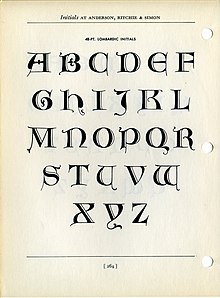Lombardic capitals
- View a machine-translated version of the Italian article.
- Machine translation, like DeepL or Google Translate, is a useful starting point for translations, but translators must revise errors as necessary and confirm that the translation is accurate, rather than simply copy-pasting machine-translated text into the English Wikipedia.
- Do not translate text that appears unreliable or low-quality. If possible, verify the text with references provided in the foreign-language article.
- You must provide copyright attribution in the edit summary accompanying your translation by providing an interlanguage link to the source of your translation. A model attribution edit summary is
Content in this edit is translated from the existing Italian Wikipedia article at [[:it:Maiuscola_longobarda]]; see its history for attribution. - You may also add the template
{{Translated|it|Maiuscola_longobarda}}to the talk page. - For more guidance, see Wikipedia:Translation.

Lombardic capitals is the name given to a type of decorative uppercase letter used in inscriptions and, typically, at the start of a section of text in medieval manuscripts.[1] They are characterized by their rounded forms with thick, curved stems. Paul Shaw describes the style as a "relative" of uncial writing.[2]
Unlike Gothic capitals, Lombardic capitals were also used to write words or entire phrases. They were used both in illuminated manuscripts and monumental inscriptions, like the bell tower of Santa Chiara, Naples. In Italian, the style is known as "Longobarda" after an earlier spelling of Lombardy (Longobardia).[3]



History
The term Lombardic comes from the study of incunabula.[4] A characteristic form of text decoration in manuscripts and early printed books with hand colouring was to use alternating red and blue Lombardic capitals for the start of each successive paragraph.[4][5] Unlike historiated or inhabited initials, Lombardic capitals are devoid of further decoration.[6]
In modern times, fonts of Lombardic capitals have been designed by many typographers, such as Frederic Goudy, who included a set as an alternative uppercase for his Goudy Text font.[7]
First, Lombardic, or the national hand of Italy, which was a development of the uncial and was first used in northern Italy. The Lombardic character is a most useful and interesting form and presents less of the fixed quality of the Roman. There are many and wide variations of it as developed by the scribes in different countries. It was the favorite form selected for initials and versals in manuscripts, which were usually painted in, in colors and gold, the solidity of the bodystrokes making it especially adaptable for this purpose. At its best this Lombardic letter preserves much of the feeling of the uncials of the sixth and seventh centuries.
— Frederic Goudy[8]
See also
- Historiated initial
- Inhabited initial
References
- ^ Harris, David (1995). The Art of Calligraphy: a practical guide to the skills and techniques (1st American ed.). London [u.a.]: Dorling Kindersley. pp. 62–4. ISBN 9780751301496.
- ^ Shaw, Paul (1982). Black Letter Primer: an introduction to Gothic alphabets (Rev. ed.). New York: Taplinger Pub. Co. p. 52. ISBN 9780800808105.
- ^ "calligrafie - ASDPS ARMIS ET LEO". www.armisetleo.it.
- ^ a b Schneider, Karin (2014). Paläographie und Handschriftenkunde für Germanisten. Eine Einführung (3rd ed.). Berlin, Boston. p. 155. ISBN 978-3-11-033704-4.
{{cite book}}: CS1 maint: location missing publisher (link) - ^ Hellinga, Lotte (2018). Incunabula in Transit: People and Trade. Leiden, Boston: Brill. pp. 183–184. ISBN 978-90-04-34036-7. Retrieved 27 February 2018.
- ^ Schneider, Ulrich Johannes, ed. (2016). Textkünste. Buchrevolution um 1500 (2nd ed.). Darmstadt: Wissenschafliche Buchgesellschaft. p. 219. ISBN 978-3-8053-5100-3.
- ^ "Goudy Text Lombardic Capitals". Monotype. Retrieved 27 February 2018.
- ^ Goudy, Frederic W. (1922). The Alphabet. New York: Mitchell Kennerly. p. 21.
External links
- Lombardic Lettering at Chartres
- 14th Century ring engraved with Lombardic capitals (Victoria and Albert Museum)
- v
- t
- e
and medieval
- Roman
- Rustic
- Uncial
- Visigothic
- Merovingian
- Carolingian
- Insular script
- Beneventan
- Blackletter
- Rotunda
- Bastarda
- Georgian
- Greek
- Early Cyrillic
- Ustav
- Poluustav
- Bosančica
- Glagolitic
- Court hand
- Lombardic

 | This typography-related article is a stub. You can help Wikipedia by expanding it. |
- v
- t
- e











